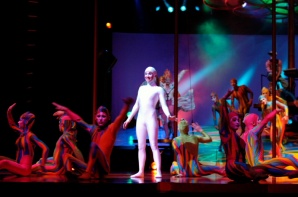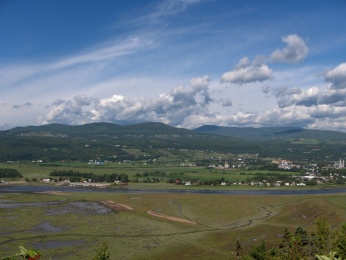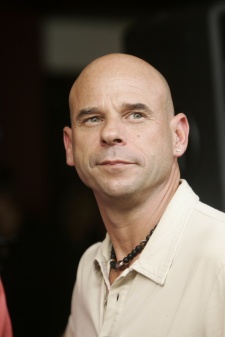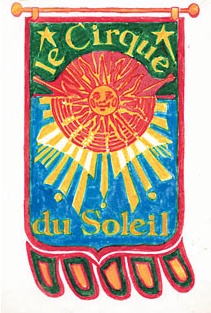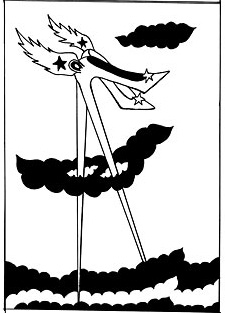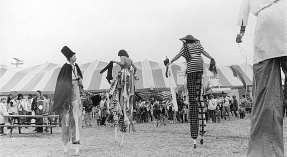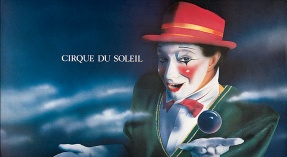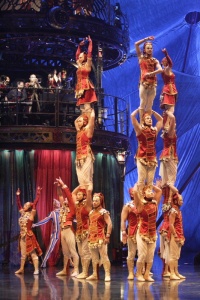Cirque du Soleil (Origins): Les Échassiers de la Baie and the Baie-Saint-Paul Fête Foraine [Festival]
par Gauthier, Serge and Harvey, Christian
To date (2009), the Cirque du Soleil is without a doubt Quebec's most internationally renowned cultural enterprise. This undeniable commercial success is the fruit of projects that took place in Baie-Saint-Paul (in the Charlevoix region) in the 1980s. At the time society was ripe for such an experimental endeavour, particularly because during the 1970s in Quebec, a substantial part of the rising generation left urban population centres in search of a different worldwith different values. As a result, many "rediscovered" Charlevoix and Baie-Saint-Paul and since, the region has become a mecca for many hippies and migrant peoples. It was truly of a case of somewhere between "the Gaspé and all the way to California," to cite Pierre Flynn. 25 years after its humble beginnings in Charlevoix, this monumental cultural enterprise today known as the Cirque du Soleil has finally taken its rightful place in the history of the community of Baie-Saint-Paul and now it constitutes an important piece of cultural heritage for Quebec.
Baie-Saint-Paul,a Place Dedicated to Creative Freedom
Charlevoix: land of the forefathers, nature, landscapes-and of a well-preserved culture. In the 70s, such ideas about the region fired the imagination of many a Quebecker. The phenomenon was primarily fed by returning vacationers, painters and folklore specialists, such as Marius Barbeau (1883-1969), one of the founding fathers of ethnology in Quebec who had spent time in the region (NOTE 1). And so, Charlevoix became the ideal location for an entire generation of young urbanites from Quebec City who embarked on a modern quest to find their roots. They were seeking to find a balance between Man and Nature, in order to live in love and harmony.
Long before that, Baie-Saint-Paul had become the home of renowned painters such as Clarence Gagnon (1881-1942) and members of the famous Groupe des Sept, during the early 20th century. Furthermore, during the 1940s and 1950s, a priest from Baie-Saint-Paul, Father Jean-Paul-Médéric Tremblay (1918-1999) was given charge of a group of young people called Équipiers de Saint-Michel. The philosophy of this particular group rested on the concept of the nomadic lifestyle and a mentality of open-mindedness (which was quite rare at that time). The activities of this group would lay the foundations of the Balcon Vert, a Youth Hostel located at the top of Cap aux Corbeaux in Baie-Saint-Paul. Many had already associated the popular site with a place to experience a freedom of mind, and so, from the 1970s on, it became a meeting place for many creative young people. During the same period, communes were flourishing in abandoned fields at the end of the range roads of Baie-Saint-Paul, Les Éboulements and Saint-Aimé-des-Lacs areas. Other decided to stay a while at Le Balcon Vert. The Youth Hostel would somewhat become the nerve centre of a growing cultural scene. In 1974, a non-profit organisation was created, in order to ensure that Le Balcon Vert would be properly managed. And so it was that young travellers on a very tight budget were able to stay in Baie-Saint-Paul for quite some time. With the years, the growing hippie population living there would come to have quite an impact on cultural life in Quebec.
The Creation of the Échassiers de la Baie
The birth of the Cirque du Soleil in 1984 came out of a project that was started a few years earlier by a team of employees from Le Balcon Vert in Baie-Saint-Paul. An important step was achieved with creation of the entertainment group Échassiers de la Baie [Stilt-walkers/Waders from the Bay (note that in French there is a play on words here)] in 1980. Under the leadership of Gilles Ste-Croix, the group would assemble a number of artisans looking for a novel cultural experience.
In the spring of 1979, Gilles Ste-Croix was hired as the manager of Le Balcon Vert and was working to create a summer activity program that year. One particular project interested him; for, not long before, he had gone to see a show produced by Peter Schumann at the Bread and Puppet Theatre in Vermont (NOTE2).The shows made considerable use of giant puppets and the effect was so striking, he was inspired to put a similar group of artists together. The only difference would be that his show would feature legendary characters from Quebec's history and legends. The challenge was that Gilles Ste-Croix had only a few individuals whom he could count on to help him with the endeavour. However, just before the tourist season began, Guy Laliberté had unexpectedly arrived at Le Balcon Vert in Baie-Saint-Paul. Originally, he had intended to work in James Bay, where he expected to quickly make the money he needed to pay for his studies in nuclear engineering (NOTE 3), but his plans were set back by a strike among the workers that had prevented him from working there. And so, Laliberté found himself in Baie-Saint-Paul, where he was hired as an activity coordinator in exchange for lodging. A proactive young man, Guy Pantoufle(slippers) Laliberté would eventually even be chosen to be a candidate for the Parti Rhinocéros in 1980. As a member of the party, one of his audacious proposals was to build a macramé bridge between Saint-Joseph-de-la-Rive and Isle aux Coudres - a project that was certainly a demonstration of his originality and imagination. Another young mover and shaker was Daniel Gauthier, who, after his studies in management, became the manager and accountant for Le Balcon Vert. It was thus that the core of the Cirque du Soleil enterprise came to be.
In March 1980, Gilles Ste-Croix and Sylvain Néron officially founded the Échassiers de la Baie Enr., an entertainment and artist agency. They applied, without success, to the government for funding. It was Gilles Ste-Croix who then organised a stilt-o-thon that would allow them to raise funds and generate a little publicity for their project. They planned to walk all the way from Baie-Saint-Paul to Quebec City on stilts (a distance of more than 90 kilometres [56 miles]). The major challenge along the way was that the route climbs over a series of ridges known as the Caps, the highest summit being more than 740 metres [2428 feet] high. The climb is a feat in and of itself, not to mention the rest of the journey. Gilles Ste-Croix succeeded in reaching Quebec City and upon his arrival his achievement makes the front-page headlines of a local news daily known as Le Soleil [Sun]. The campaign was a success and enabled them to collect $60,000 in addition the ample free publicity for their organisation.
A Decisive First Show: Alexis le Trotteur
The first show given by the Échassiers de la Baie was centred around a legendary character from the Charlevoix region: Alexis Lapointe alias le Trotteur (1860-1924). The show, written and produced by Jean-Pierre Brouillé, included three musicians and seven actors on stilts. The premiere of the show took place on June 23rd, 1980 in the Baie-Saint-Paul hockey stadium. Alexis le Trotteur was then presented in a number of regions across Quebec. This show clearly demonstrated the artists' desire to promote the cultural heritage of the Charlevoix region where they had put down roots. It also demonstrated their interest in developing a circus act that involved people on stilts instead of the traditional show animals, which, was usually the case of almost every typical circus of the day. It was desire that would only assert itself even more with the creation of the Cirque du Soleil in 1984 and it would eventually become the trademark of the enterprise. Unfortunately, following their first year of performances, the Échassiers' operations went into the red. Gilles Ste-Croix was then obliged to create a new organisation that would be more capable of assisting with the development of new cultural activities in the region.
The Club des Talons Hauts
In 1981, a new non-profit organisation called Club des Talons Hauts [The High Heels Club] was created. Its purpose was to raise public funding through government programs, particularly employment programs. Incorporated on April 7th, 1981, this organisation would become Les Productions du Cirque du Soleil six years later. Although the Échassiers de la Baie had been little more than an entertainment agency composed of volunteers, this new enterprise would set forth to carve its own creative niche in the popular entertainment industry.
During the summer of 1981, the Échassiers continued to tour Quebec under the management of Guy Laliberté. Then a new show, called Le Défilé du Dragon [Parade], was added to the troupe's repertoire. That winter, with a subsidy of $10,000, the Échassiers de la Baie presented a new show in hockey stadiums all across the Province of Quebec during the game intermission. The show's skating stilt walkers (quite a risky feat) received only a lukewarm welcome from hockey fans. Nonetheless, the group was able to balance its budget during its second year of operations. And so, the time had come establish a common vision of the group's future, in order to be able to develop more substantial activities. Thereafter, the Fair as a long-term project began to take shape.
La Fête Foraine de Baie-Saint-Paul [The Baie-Saint-Paul Fair] (1982-1984)
It was largely due to the initiative of the Club des Talons Hauts that the fair Fête Foraine was set up in Baie-Saint-Paul. It was intended to re-create an atmosphere similar to that of a Middle Age Festival, when street performers would roamed the cities of Europe during the great market fairs of the period. This fair concept was in keeping with the concept the organisation's creators had concerning entertainment ambiance and environment. Their wish was to interact with the spectators in a more playful way, instead of being limited to the more or less rigid formal social constraints of a traditional performing environment: "When we decided that this event would take place downtown, we had a few objectives in mind: getting involved in the everyday life of the population that had encouraged our success so far, so as to be able to share with them the joy we had in just being alive" (NOTE 4). For three years in a row, from 1982 to 1984, the Baie-Saint-Paul Fair was also a tremendous success and had as many as 25,000 spectators in 1983. For a whole week, the streets of Baie-Saint-Paul became the playground of a new generation of circus artists from Quebec, Canada, the United States and Europe. But the 1984 edition of the Fair, a key program activity of the Grand Tour, was the year that would have the greatest impact on the group's success.
The 1984 Grand Tour
1984 was the year of the 450th anniversary of Jacques Cartier's arrival in Canada (1534-1984). A large number of events were organised all around the province and the Club des Talons Hauts took advantage of the Fair as an occasion to propose creating a circus. At first, the then Minister of Cultural Affairs, Clément Richard ,showed little interest in the idea. But Guy Laliberté was tenacious and persevering; he went all the way to the capital to directly meet with the Prime Minister of Quebec, René Lévesque, who ended up granting him a large sum of money on the behalf of the Government of Quebec. And so, it was then settled-and that is how the Cirque du Soleil was born.
The Grand Tour allowed the Cirque du Soleil to give performances in 11 cities across the Province of Quebec. One of the few successful events of the 450th anniversary celebrations of Cartier's arrival, the Grand Tour opened the door of opportunity for the Cirque du Soleil. The group would eventually take its triumphant first tour of the United States in 1987, but before that was to happen, the artists would have to see some other commitments through, although the outcome of some of them would be unpredictable. One such unpredictable event occurred when the group applied for a subsidy at the Baie-Saint-Paul Municipal Council to help with the financing of the 1986 edition of the Baie-Saint-Paul Fair. Unfortunately, the city's administration refused and it was at that point that the Fair ceased to exist. Because of this missed opportunity, the Cirque du Soleil's artists began to look abroa dfor other possibilities. Thus, it was outside Canada that the group quickly became a tremendous success.
A Return to the Origins of Cirque du Soleil
For most spectators of the Cirque du Soleil, up until 2009, they had no way of knowing that the group was from Baie-Saint-Paul, although the, since the 80s, the region had been considered to be a place where the visual arts thrived. It was only in 2005, that the Société d'Histoire de Charlevoix, gave an account of this astonishing tale in one of its publications of the Revue d'Histoire de Charlevoix (NOTE 5). However, in order to commemorate the 25th anniversary of the founding of the Cirque du Soleil, Baie-Saint-Paul would organise a series of activities to commemorate the event which they called L'Éveil du Géant [TheAwakening of the Giant]. The celebration paid tribute to the entertainment group's history in a number of ways including a display of costumes at the Musée d'Art Contemporain de Baie-Saint-Paul from the Cirque du Soleil's various shows, photo exhibitions and the unveiling of a commemorative monument. And so, during the summer of 2009, Baie-Saint-Paul's streets were once again full of street performers, just as it once was during the Fair, The event was intended to recreate a part of the Circus' interesting and not so distant past.
Moreover, in an unexpected turn of events, the former second member of the Cirque du Soleil management team, businessman Daniel Gauthier, purchased the Le Massif ski resort in Petite-Rivière-Saint-François in 2002. With the financial assistance from two levels of government, he planned to build a 230 million dollar resort in the Baie-Saint-Paul area. It would include the construction of a hotel and the reconstruction of the Quebec-La Malbaie railway(an important piece of historical heritage for the Charlevoix region). However, in Baie-Saint-Paul, it seems that no future shows or more permanent projects in connection with the origins of the Cirque du Soleil are planned to take place in area in the near future. Regardless of the situation, Baie-Saint-Paul and Charlevoix can nonetheless anticipate to continue renewing the enthusiasm, leadership and creativity that was once the basis on which the now world renowned circus was founded.
Christian Harvey
Historian, Centre de Recherche sur l'Histoire et le Patrimoine de Charlevoix
[Research Institute for Charlevoix Heritage and History]
Serge Gauthier
Historian, Centre de Recherche sur l'Histoire et le Patrimoine de Charlevoix
NOTES
Note 1. Gauthier, Serge, Charlevoix ou la Création d'une Région Folklorique, Quebec, Laval Presses de l'Université Laval, 2006.
Note 2. Tony Babinski, Cirque du Soleil. 20 Ans Sous le Soleil. L'Histoire Authentique, Montreal, HMH Hurtubise, 2004, p. 21; Beaunoyer, Jean, Dans les Coulisses du Cirque du Soleil, Montreal, Québec Amérique, 2004. p. 26.
Note 3. Babinski, p 24.
Note 4. Plein-Jour sur Charlevoix, July 14th, 1982.
Note 5. Harvey, Christian, "Des Échassiers de la Baie au Cirque du Soleil", Revue d'Histoire de Charlevoix, 50 (October 2005) : 2-9.
BIBLIOGRAPY
BABINSKI, Tony, Cirque du Soleil. 20 ans sous le soleil, L'histoire authentique, Montréal, HMH Hurtubise, 2004.
BEAUNOYER, Jean. Dans les coulisses du Cirque du Soleil, Montréal, Québec Amérique, 2004.
HARVEY, Christian, « Baie-Saint-Paul, un lieu de création au tournant des années 1980. Des Échassiers de la Baie au Cirque du Soleil », Revue d'histoirede Charlevoix, 50 (Octobre 2005) : 2-9.
Additional DocumentsSome documents require an additional plugin to be consulted
Images
-
Annonce d'un partenar
iat entre le Ci... -
Cirque du soleil, ouv
erture de Salti... -
Daniel Gauthier
-
 Les Chemins qui march
Les Chemins qui march
ent, Québec, 20...
-
Spectacle KOOZA, avri
l 2007 -
Spectacle KOOZA, avri
l 2007 -
Spectacle KOOZA, avri
l 2007 -
 Spectacle Les Chemins
Spectacle Les Chemins
qui marchent, ...
Hyperliens
- The Canadian Encyclopedia: Cirque du Soleil
- Official Site: Cirque du Soleil History
- Un cirque en Amérique, by Nathalie Petrowski, 1989, 50 min 22 s (NFB documentary on the Cirque du Soleil on tour in New York, 1988)
- [IN FRENCH] Société historique de Charlevoix

